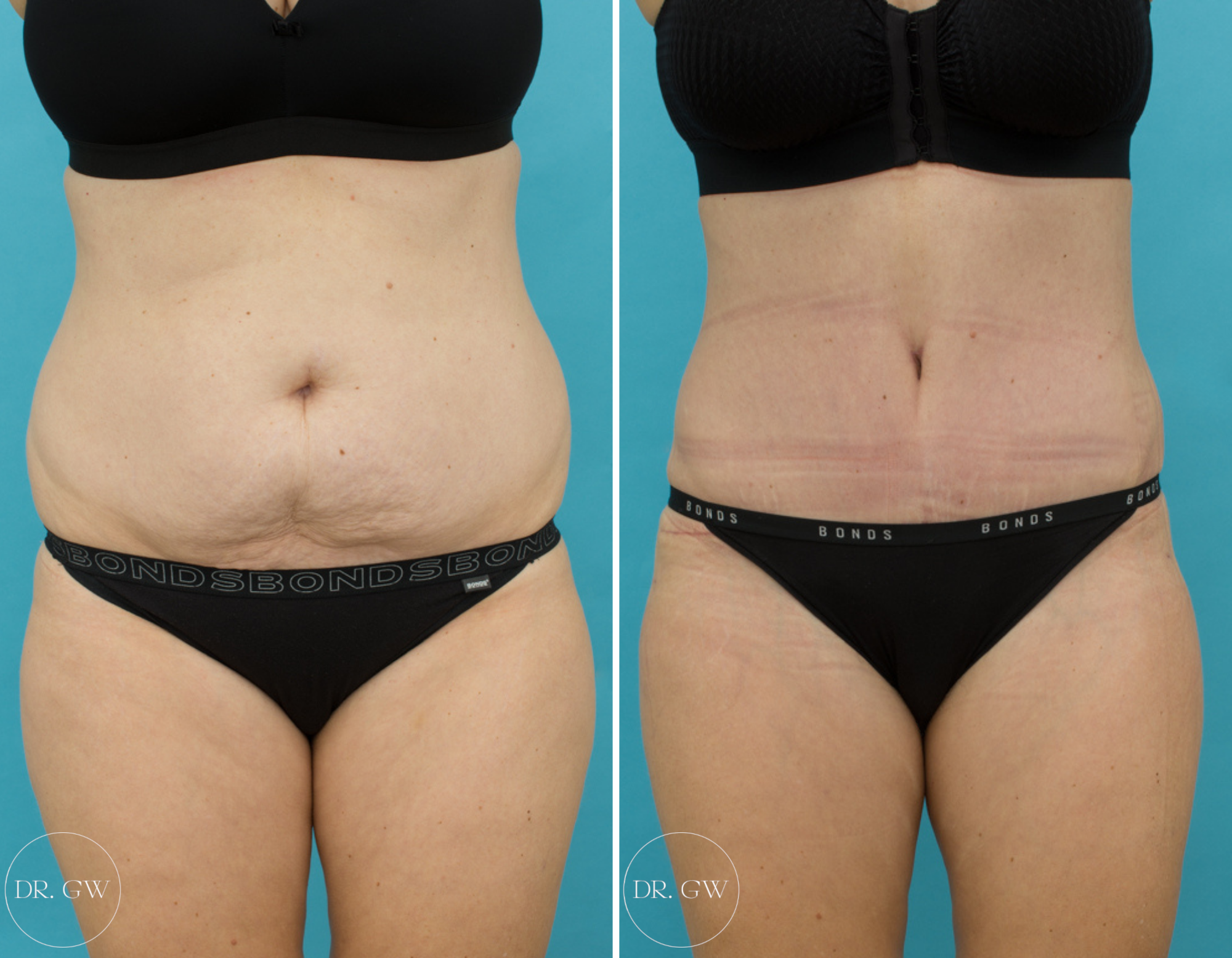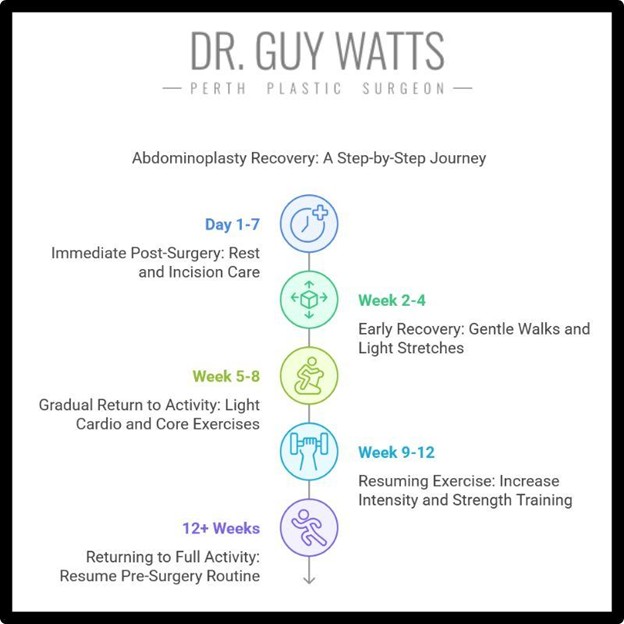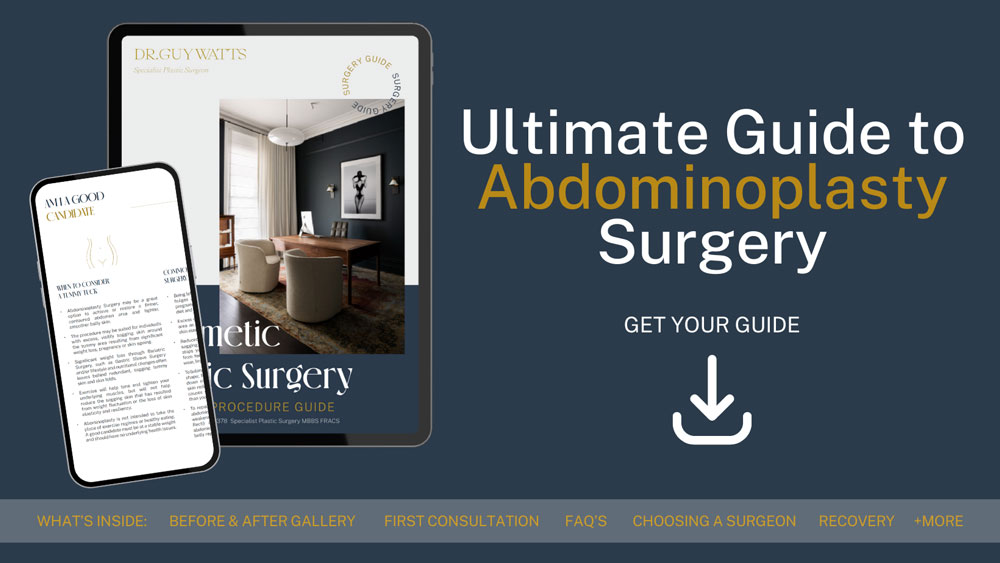
02 Jul Exercise after Tummy tuck – Returning to Exercise after Abdominoplasty
When Can I Exercise after a Tummy tuck – Abdominoplasty
If you’re considering a tummy tuck – abdominoplasty or have recently undergone the procedure, you may be wondering when and how to safely return to exercise. You should know that while a tummy tuck – abdominoplasty can provide good results in eliminating excess skin and tightening your abdominal area, the success of your surgery and long-term benefits greatly depend on proper post-operative care and a well-planned return to physical activity.
Perth Specialist Plastic Surgeon Dr. Guy Watts emphasises the importance of a gradual and guided approach to exercising after a tummy tuck – abdominoplasty. With his experience and commitment to patient care, Dr. Watts and his team are dedicated to helping you go through the recovery process and safely reintegrate exercise into your routine.
Take our quiz, and find out if you are ready for surgery
What You Need to Know about the Tummy Tuck/ Abdominoplasty Procedure
A tummy tuck – abdominoplasty is a surgical procedure designed to remove excess skin and fat from the abdominal area while tightening the underlying muscles. This procedure is often recommended for individuals who have experienced significant weight loss, pregnancy, or age-related changes in their midsection.
When considering a tummy tuck – abdominoplasty, it’s essential to understand the importance of proper recovery and closely following your surgeon’s post-operative instructions.
While it may be tempting to rush back into your regular exercise routine to maintain your tummy tuck – abdominoplasty results, you should know that your body needs time to recover from the surgical procedure. Engaging in strenuous activities too soon can lead to complications, delayed healing, and compromised results. Your plastic surgeon and his team will work closely with you to develop a personalised recovery plan that balances rest and gentle movement to promote healing and prevent complications.
As you progress through your recovery, incorporating exercise will become an integral part of maintaining your tummy tuck – abdominoplasty results and overall health. Regular physical activity helps to strengthen your core muscles, improve posture, and prevent weight gain, all of which contribute to the longevity of your tummy tuck – abdominoplasty outcomes.
Abdominoplasty Recovery Timeline
Recovering from a tummy tuck – abdominoplasty is a gradual process that requires patience and adherence to your surgeon’s guidelines.

Immediate Post-Surgery (Day 1-7):
- Rest is your top priority during this initial phase. You’ll need to take short walks around your home to promote circulation and prevent blood clots.
- Manage pain and discomfort with prescribed medications and follow your surgeon’s instructions for changing dressings and caring for your incision.
- Avoid bending, lifting, or straining your abdominal muscles. Sleep in a slightly reclined position to minimise pressure on your incision.
Early Recovery (Week 2-4):
- As your pain subsides, you can begin taking longer, gentle walks indoors or outdoors, as tolerated.
- Continue to avoid lifting anything heavier than 5-10 pounds and any activities that engage your core muscles.
- Begin light, lower body stretches and exercises as directed by your surgeon to improve circulation and flexibility.
- Attend follow-up appointments with your surgeon to monitor your healing progress and discuss any concerns.
Gradual Return to Activity (Week 5-8):
- With your plastic surgeon’s approval, you can slowly introduce light cardiovascular activities, such as walking on a treadmill or using a stationary bike with low resistance.
- Begin gentle core exercises, focusing on small, controlled movements and proper breathing techniques.
- Continue to avoid high-impact activities, lifting heavy weights, or exercises that put direct strain on your abdominal muscles.
- Wear your compression garment as directed to minimise swelling and support your healing tissues.
Resuming Exercise (Week 9-12):
- As your strength and energy levels improve, you can gradually increase the intensity and duration of your cardiovascular workouts.
- Incorporate low-impact exercises like swimming, cycling, or using an elliptical machine, as these activities put less stress on your healing incision.
- Begin strength training exercises for your upper and lower body, using light weights and focusing on proper form.
- Avoid abdominal exercises like crunches or sit-ups until you receive clearance from your plastic surgeon.
Returning to Full Activity (12+ Weeks):
- With your plastic surgeon’s approval, you can gradually resume your pre-surgery exercise routine, including abdominal exercises and weightlifting.
- Listen to your body and progress slowly, paying attention to any discomfort or fatigue.
- Maintain a consistent exercise routine to support your tummy tuck – abdominoplasty results and overall health.
DOWNLOAD DR WATTS’ GUIDE TO ABDOMINOPLASTY

Myth vs. Fact about Exercise after Tummy Tuck – Abdominoplasty
When it comes to exercising after a tummy tuck – abdominoplasty, there are some myths and misconceptions that can lead to confusion and potentially compromise your recovery. Let’s address some of the most common myths and provide evidence-based facts to set the record straight:
Myth 1: You can resume your regular exercise routine immediately after surgery.
Fact: Engaging in strenuous exercise too soon after a tummy tuck – abdominoplasty can lead to complications, delayed healing, and compromised results. Your body needs time to recover, and it’s important to follow your surgeon’s guidelines for gradually reintroducing physical activity.
Myth 2: Exercise can help speed up the healing process.
Fact: While gentle movement, such as short walks, can promote circulation and prevent blood clots, engaging in intense exercise too early can actually hinder the healing process. Excessive strain on your incision and abdominal muscles can lead to swelling, bruising, and increased discomfort.
Myth 3: You should avoid all exercise for several months after a tummy tuck – abdominoplasty.
Fact: While it’s essential to avoid strenuous exercise during the initial recovery period, complete inactivity can lead to muscle weakness and decreased flexibility. Dr. Guy Watts recommends a gradual return to exercise, starting with gentle activities and progressively increasing intensity.
Myth 4: You can target specific areas of fat with exercise after a tummy tuck – abdominoplasty.
Fact: Spot reduction is a myth. While exercise can help tone and strengthen your muscles, it cannot selectively target fat in specific areas. Maintaining a balanced diet and regular exercise routine is key to sustaining your tummy tuck – abdominoplasty results.
The Do’s and Don’ts of Post-Tummy tuck – Abdominoplasty Exercise
To ensure a safe and successful recovery after your tummy tuck – abdominoplasty, make sure to follow guidelines for post-surgical exercise. Here, you can find a table with a clear list of activities that are safe and recommended at different stages of recovery, as well as exercises and activities to avoid:
| Time Period | Do’s | Don’ts |
|---|---|---|
| Day 1–7 |
|
|
| Week 2–4 |
|
|
| Week 5–8 |
|
|
| Week 9–12 |
|
|
When modifying exercises or returning to physical activity, always listen to your body’s cues. If you experience pain, discomfort, or excessive fatigue, stop the activity and consult with your plastic surgeon.
FAQs about Exercise after Tummy Tuck – Abdominoplasty
Further Reading about Abdominoplasty
- Read more about Benefits of Wearing Compression Garments after Tummy tuck – abdominoplasty
- Read more about Belly Bulge After Baby: Is It Diastasis Recti, Abdominal Fat, or Both?
- Read more about BMI Impact on Abdominoplasty Results
- Read more about Minimising Scars after Abdominoplasty Surgery
About Dr. Guy Watts – MED0001539378
FRACS (Plas) – Specialist Plastic Surgeon In Perth WA
Dr. Guy Watts is a Specialist Plastic Surgeon (AHPRA MED0001539378) with an extensive career that spans across renowned plastic surgery clinics worldwide. His experience has been honed through invaluable experiences at esteemed establishments such as the New York Eye and Ear Infirmary and the renowned Pitanguy Clinic in Brazil.
Having collaborated with the foremost cosmetic plastic surgeons on a global scale, Dr. Watts has chosen to return to Perth after a 17-year journey of intensive training and invaluable professional experience to bring the latest practices and technology in cosmetic plastic surgery to his patients.
Dr. Watts is a Fellow of the Royal Australasian College of Surgeons (FRACS) and a Member of the Australian Society of Plastic Surgeons (ASPS), Australasian Society of Aesthetic Plastic Surgeons (ASAPS) and the International Society of Aesthetic Plastic Surgeons (ISAPS).
Read about the potential Risks and Complications of Surgery
Read the Patient Information and Resources
About CLINISPA
Clinispa is Dr Watts’ bespoke medical clinic performing Cosmetic Aesthetic treatments. At Clinispa, we offer advanced clinical treatments in a luxurious and calming environment, tailored to support your skin’s health and appearance.
Clinispa aesthetic services are performed by Dr Guy Watts’ nursing professionals, who have a passion for and solid understanding of facial aesthetics.
All Clinispa clients are considered individually, with a personalised treatment plan consisting of advanced scientific approaches to cosmetic aesthetics. We incorporate innovative technologies in conjunction with superiorly formulated skin care.
For more information about the full range of Clinispa Aesthetic of Cosmetic Treatments visit the Clinispa website








Sorry, the comment form is closed at this time.